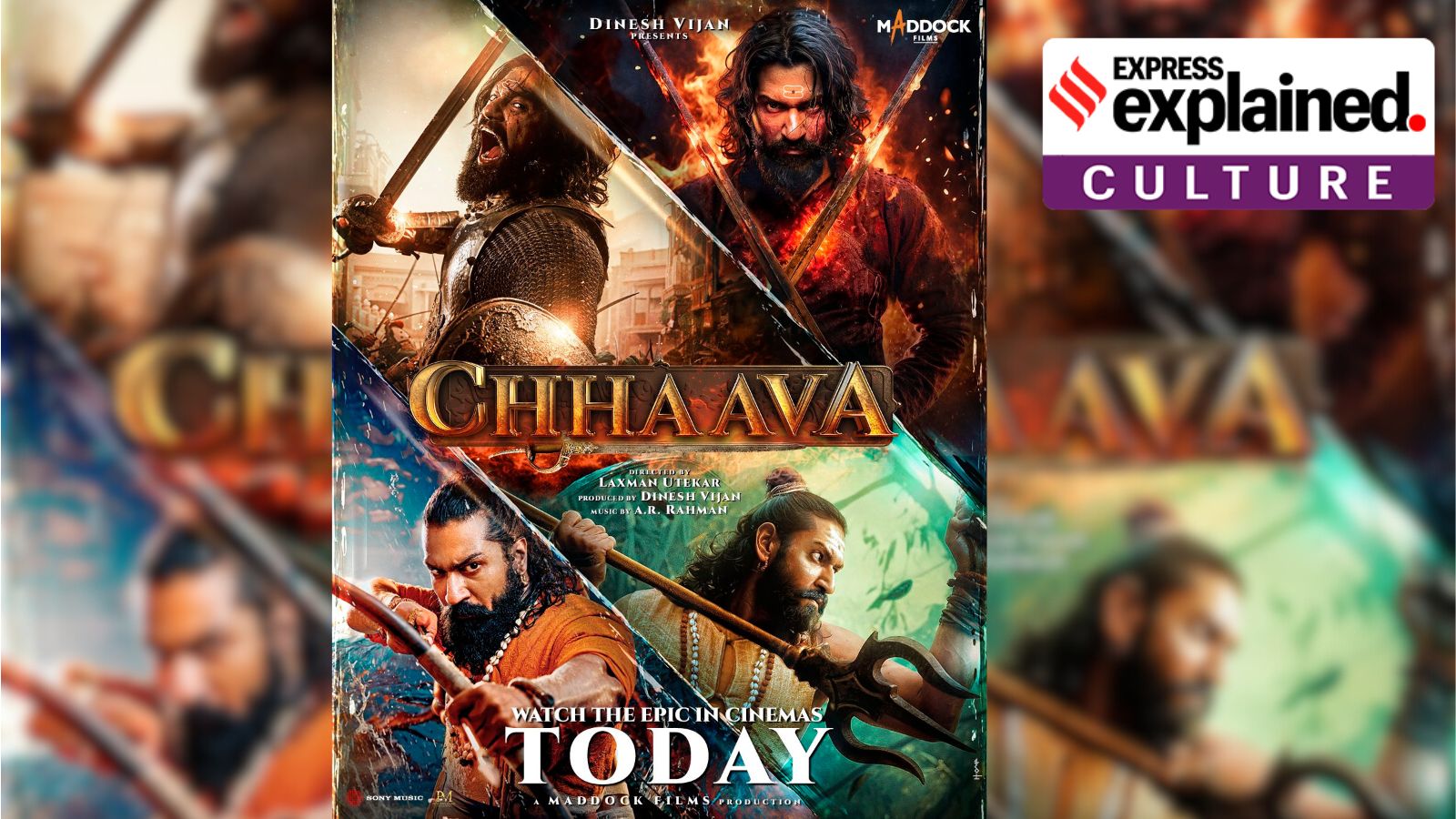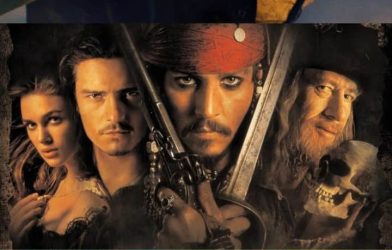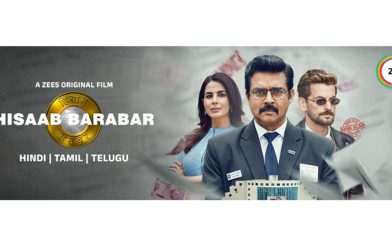With the success of the Vicky Kaushal-starrer Chhava, the spotlight is on the historical film genre in Indian cinema. Within 10 days of its release, the Hindi film has grossed nearly 450 crores. It is based on the life of Maratha ruler Chhatrapati Sambhaji Maharaj (1657-1689), who was the son of Chhatrapati Shivaji Maharaj (1630-1680), the founder of the Maratha empire.
Sambhaji’s rule was largely shaped by the Marathas’ wars with the Mughal Empire, the Siddis of Janjira, the Wadiyars of Mysore, and the Portuguese Empire. Among the major military campaigns he launched was the attack on Burhanpur, an important Mughal city and trading centre in present-day Madhya Pradesh. He did this to stop Mughal emperor Aurangzeb from expanding his footprint in the Deccan. Their fight is what Chhava largely deals with.
There has been a rise in biopic-like films based on historical figures and incidents in the last decade (like the Oscar-winning RRR, Akshay Kumar’s Kesari, and the recent Tamil film Amaran), often nationalistic in their tone. However, Indian film industries have a rich and long history of making movies rooted in the past. Here is a look at five prominent examples across industries, and what they say about the genre’s evolution.
- 01
Veerapandiya Kattabomman (Tamil, 1959)
Directed by B R Panthulu, the film stars Sivaji Ganesan who is considered among the greats of the Tamil film industry. Veerapandiya Kattabomman is epic in scale and is a loose adaptation of the life and times of an 18th-century king who rebelled against the East India Company.
The film was a phenomenal success, with commentators calling it a prime example of the use of the cinematic medium for instilling a sense of ‘Tamil pride’ in audiences, as was often the case in early Tamil films. Its re-releases in 1984 and 2015 were also well-received.
 Veerapandiya Kattabomman, starring Ganesan. (Prime Video)
Veerapandiya Kattabomman, starring Ganesan. (Prime Video)The film’s highly stylised set pieces and dialogue-heavy narrative have found echoes in several other historical and mythological films that followed, and remain a staple.
The film was most recently showcased at the International Film Festival Rotterdam (IFFR) 2025. Its citation read: “B.R. Panthulu’s Gevacolor period epic Veerapandiya Kattabomman, valorising an eighteenth-century Southern Indian chieftain’s defiance of the colonial East India Company, has such an outsized influence on the Tamil imagination that the legend it forged has overshadowed all factually informed accounts… The valiant image Kattabomman enjoys today owes largely to the fiery, thunderous portrayal by Sivaji Ganesan, who won the Best Actor award at the second Afro-Asian Film Festival in Cairo in 1960.”
- 02
Bhumika (Hindi, 1977)
Shyam Benegal’s Bhumika, starring Smita Patil in the lead role, is based on the memoirs of Hansa Wadkar, often called one of the first Marathi superstars in the 1940s. Known for her bohemian and unconventional lifestyle, as well as for her tempestuous personal life, Wadkar became known for her contribution to the genres of devotional and ‘Tamasha’ films in Marathi cinema.
 ‘Bhumika’, starring Smita Patil. (Amazon)
‘Bhumika’, starring Smita Patil. (Amazon)Bhumika paved the way for realistic biopics. Echoes of Bhumika can be found in the Telugu film Mahanati (2018), which was a biopic of actress Savitri. Notably, both Bhumika and Mahanati won their leading ladies, Smita Patil and Keerthy Suresh, National Awards for the Best Actress.
- 03
1921 (Malayalam, 1988)
Starring actors Mammootty, Suresh Gopi, Mukesh, Urvashi, and Madhu, 1921 is a war epic that takes place during the 1921-22 Mappila Uprising in the Malabar region, under what was then the Madras Presidency. Led by Muslim tenants, it opposed local Hindu landlords and British colonial rule.
 ‘1921’, staring Mammootty. (Wikimedia Commons)
‘1921’, staring Mammootty. (Wikimedia Commons)While the film tells the fictional story from the perspective of a World War I veteran, the events at its centre did happen. The history itself has been a subject of academic debate, but the film nevertheless won laurels upon its release.
Films based on the Independence movement, especially those that depict lesser-known tales, have usually found both critical and commercial success – Chhava star Vicky Kaushal played freedom fighter Sardar Udham Singh in a 2021 biopic, which was appreciated for its performances, story, and screenplay.
Other examples include Dr Babasaheb Ambedkar (2000), also starring Mammootty; Alluri Seetarama Raju (1974), which starred Telugu star Krishna; Kappalottiya Thamizhan (1961), another Sivaji Ganesan-starrer; and Rang De Basanti (2006), which took a modern approach to the stories of Bhagat Singh, Chandra Shekhar Azad, Rajguru, Ashfaqullah Khan, Durgawati Devi and Ram Prasad ‘Bismil’.
- 04
Annamayya (Telugu, 1997)
Indian biopics have often dealt with religious and devotional themes – a prime example is the Telugu film Anammayya, which stars Nagarjuna in the lead role as Annamacharya, a 15th-century composer and saint. He is said to have pioneered ‘kirtans’ or religious musical performances in the Indian subcontinent and called the ‘Andhra Pada Kavita Pitamaha’, or the Grandfather of Telugu song-writing.
 ‘Annamayya’, starring Nagarjuna. (Wikimedia Commons)
‘Annamayya’, starring Nagarjuna. (Wikimedia Commons)In the essay ‘Religious and Devotional Music: Southern Area’, included in The Garland Encyclopedia of World Music (1999), William Jackson wrote that Annamacharya was also one of the first religious thinkers to oppose caste-based hierarchies in the 15th century. Other popular Indian films that depicted the lives of religious leaders include Jagadguru Adi Sankara (2013), also starring Nagarjuna; Nanak Shah Fakir (2015), a Punjabi film depicting the life of Guru Nanak; and Vishwaguru (2017), a Malayalam film based on the life of social reformer Narayana Guru.
- 05
Jodhaa Akbar (Hindi, 2008)
The Mughal empire and its kings have been the subject of many Indian biopics, particularly in Bollywood. Mughal-e-Azam (1960) is regarded widely as one of the finest Hindi films of all time, and essentially immortalised the images of its three stars: Prithviraj Kapoor as Emperor Akbar, Dilip Kumar as his son Salim, and Madhubala as the courtesan Anarkali.
 A poster of ‘Jodhaa Akbar’. (Wikimedia Commons)
A poster of ‘Jodhaa Akbar’. (Wikimedia Commons)The legends of the Mughal royalty continued to enthral viewers even in the 21st century. Jodhaa Akbar, directed by Ashutosh Gowariker and starring Aishwarya Rai Bachchan and Hrithik Roshan in the titular roles, was the fourth-highest grossing film of 2008 and has remained a fan favourite ever since despite its runtime of over three hours. The film’s success even led to a Hindi television series of the same name, created and developed by producer Ektaa Kapoor, and starring Paridhi Sharma and Rajat Tokas in the lead roles.
However, this does not mean that making history-inspired films guarantees success. Films that were not well-received by audiences or critics alike include Samrat Prithviraj (2022), Panipat (2019), and Mangal Pandey: The Rising (2005).
One reason filmmakers nonetheless bet on them is linked to how Indian history and mythology continue to play an outsize role in the broader culture. Artworks based on such themes are thus likely to be impactful in how they can even elicit emotional responses from audiences. Apart from films, TV shows and books based on history have also become popular. Controversies over the accuracy of these works further helps generate interest around them.
© IE Online Media Services Pvt Ltd











